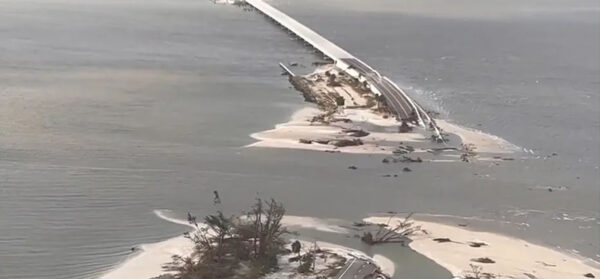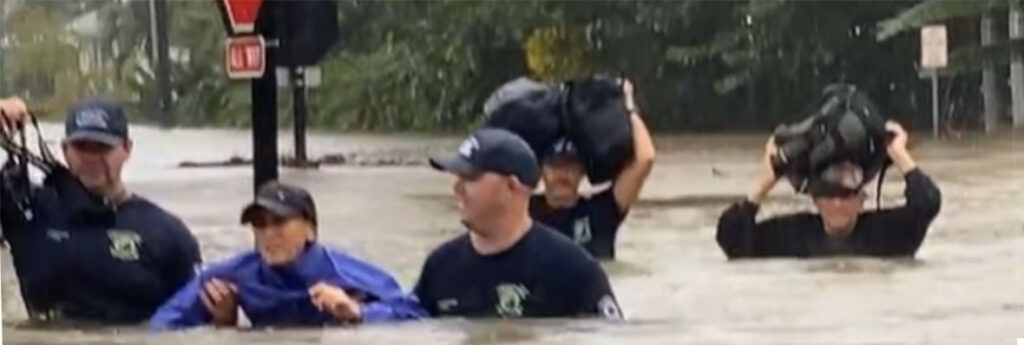Rescue crews piloted boats and waded through flooded streets Thursday to save thousands of Floridians trapped after Hurricane Ian destroyed homes and businesses and left millions in the dark.
The devastation began to come into focus a day after Ian made landfall in Florida as one of the strongest hurricanes ever to hit the US. The storm flooded homes on both the state’s coasts, cut off the only bridge to a barrier island, destroyed a historic waterfront pier and knocked out electricity to 2.67 million Florida homes and businesses – nearly a quarter of utility customers. At least one man was confirmed dead.
Aerial photos from the Fort Myers area, a few miles west of where Ian struck land, showed homes ripped from their slabs and deposited among shredded wreckage. Businesses near the beach were completely razed, leaving just twisted debris. Broken docks floated at odd angles beside damaged boats, and fires smoldered on lots where houses once stood.
“We’ve never seen storm surge of this magnitude,” Florida Gov. Ron DeSantis said. “The amount of water that’s been rising, and will likely continue to rise today even as the storm is passing, is basically a 500-year flooding event.”
Though downgraded to a tropical storm by Thursday morning, the National Hurricane Center said storm surge and flooding rains remained a threat as Ian crept across the Florida peninsula and emerged in the Atlantic Ocean north of Cape Canaveral. Forecasters predicted Ian would regain strength while turning northward.
A hurricane warning was issued for the South Carolina coast, where the storm was expected to again make landfall.
Sheriffs in southwest Florida said 911 centers were inundated by thousands of stranded callers, some with life-threatening emergencies. The US Coast Guard began rescue efforts hours before daybreak on barrier islands near where Ian struck, DeSantis said. More than 800 members of federal urban search-and-rescue teams were also in the area.
In the Orlando area, Orange County firefighters used boats to reach people in a flooded neighborhood. At an area nursing home, patients were carried on stretchers across floodwaters to a waiting bus.
Despite the utter devastation in parts of Fort Myers, some people left shelters to return home Thursday afternoon. Long lines formed at gas stations and a Home Depot opened, letting in a few customers at a time.
Authorities confirmed at least one Florida death – a 72-year-old man in Deltona who fell into a canal while using a hose to drain his pool in the heavy rain, the Volusia County Sheriff’s Office said. Two other storm deaths were reported in Cuba.
Lee County Sheriff Carmine Marceno said his office was scrambling to respond to thousands of 911 calls in the Fort Myers area, but many roads and bridges were impassable.
“We still cannot access many of the people that are in need,” Marceno told ABC’s “Good Morning America.
Emergency crews sawed through toppled trees to reach stranded people. Many in the hardest-hit areas were unable to call for help because of electrical and cellular outages.

A chunk of the Sanibel Causeway fell into the sea, cutting off access to the barrier island where 6,300 people live. It was unknown how many heeded orders to evacuate, but Charlotte County Emergency Management Director Patrick Fuller expressed cautious optimism.
No deaths or injuries have been confirmed in the county, and flyovers of barrier islands show “the integrity of the homes is far better than we anticipated,” Fuller said.
South of Sanibel Island, the historic beachfront pier in Naples was destroyed, with even the pilings underneath torn out. “Right now, there is no pier,” said Penny Taylor, a Collier County commissioner.
In Port Charlotte, a hospital’s emergency room flooded and fierce winds ripped away part of the roof, sending water gushing into the intensive care unit. The sickest patients – some on ventilators – were crowded into the middle two floors as the staff prepared for storm victims to arrive, said Dr. Birgit Bodine of HCA Florida Fawcett Hospital.
Ian struck Florida as a monstrous Category 4 storm, with 150 mph (241 kph) winds that tied it for the fifth-strongest hurricane ever to hit the US.
While scientists generally avoid blaming climate change for specific storms without detailed analysis, Ian’s watery destruction fits what scientists have predicted for a warmer world: stronger and wetter hurricanes, though not necessarily more of them.
“This business about very, very heavy rain is something we’ve expected to see because of climate change,” said MIT atmospheric scientist Kerry Emanuel. “We’ll see more storms like Ian.”
Even after weakening, Ian’s tropical storm-force winds still reached 415 miles (667 kilometers) from its center. Forecasters predicted the Atlantic waters would strengthen it to a Category 1 hurricane before it makes landfall Friday in South Carolina.
The National Hurricane Center warned storm surge of 6 feet (1.83 meters) or more was possible from Daytona Beach, Florida, to north of Charleston, South Carolina. Rainfall of up to 8 inches (20.32 centimeters) threatened flooding in the Carolinas and Virginia.

